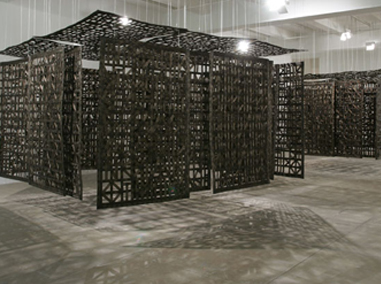Cristina Iglesias & the Sleight of Hand

Cristina Iglesias, Double Pavillion Suspended in a Room, 2005, braided wire, steel cables - 50 screens, each 72.80 x 47.25 in.
Cristina Iglesias’s new installations at the Marian Goodman gallery are best experienced through an investigation of what they aren’t, achieving a rare level of the semiotic quality in sculpture that simultaneously seduces and excludes, an articulation akin to the most alluring yet cryptic prose in literature.
Iglesias uses industrial, unforgiving materials, casts an alchemical spell to transform wire into sumptuous braids which resemble reeds or rattan in Double Pavilion Suspended in a Room. Their identity is further compounded by welding marks or a near-decorative pattern of elaborate patina which unifies the braids into sections of open basket-woven panels, suspended by steel cables in a shape that evokes ancient temples, prayer spaces, or even the pagoda-shaped mall kiosk.
The shadows mark mysteries on the walls and floor, and in peering between the layers of the panels, a complex archetypal geometry forms itself into obscured letters, teasing yet another implication in the space. A temptation arises to be inside the room created, which looking outward reveals a sanctuary, a hidden place imbued with the serene sense of protection. In this way, Iglesias engages the whole body in a participatory, complicit sense, both creating and fulfilling visceral longing in an intellectual, distantly spiritual connection.
The disconnects begin when the viewer detaches from his corporeal integration – sudden breaks of logic and sensation quiet the spells and create an overpowering disengagement as the reality of what the work is not begins to condense. Following the steel cables upward, there is a jarring realization that this work is not magically or ephemerally suspended; it is brutally honest in that it is simply screwed into the gallery ceiling. What appeared as a unified construction reveals itself as fifty modular screens which do not even touch each other. Looking again at those magical and enchanting shadows, one sees what they are cast upon: the vulgar white walls and standard grey floor. In such hard disorientation, one could even become distracted by the construction just outside the window, scaffolding echoing the intriguing shapes, it too shrouded in a mesh of craftily deceptive material.
Here in these breaks, the concavity flexes back out into convexity – the optical illusions of completeness reassemble – and the true capability and adaptive nature of Iglesias’s transformation reappears in a startling fullness, made more intense by the separations and jolts of actuality. She has made both of these worlds real in the same place.
A similar effect occurs in the South room installation Pasillio Vegetal III, where fiberglass, polyester resin, and patinated bronze powder are transfigured into teeming vine-like surfaces, lush and writhing with vitality. Thirty-eight panels become a massive serpentine corridor, reminiscent of a very organic Richard Serra. As the viewer is captivated by the depth in the range of muted greens and browns, he is drawn in to the surface, pulled through the doorway into what seems to be an inviting, if slightly intimidating, secretive place.
Suddenly it stops – the walls curl tightly into a claustrophobic cul-de-sac, and what was once the threshold of possibility tightens into captivation and domination. The scale of experience shifts dramatically to suffocation, as if a wrong turn led down a well. The white rabbit cannot be far off.
Emerging back out, the transformative power of this space is disorienting, especially when considered in view of the long white hall that led into it. How can a space change so quickly from an intriguing gracious hostess to a hulking, leering trap? Herein again lies the power Iglesias has to involve the whole body and through it, our most open and genuine relation to the work. With subtle intensity and fascinating twists, a surreality is both fabricated and deconstructed before us, addressing and confounding our bodies with illusion and detailed surface, while distorting, disrupting, and startling our grasp on the moment with a well-played sleight of hand.
Cristina Iglesias activates new possibilities in aesthetic experience, through masterful illusory use of materials and space and clever exchanges with the body. Dynamic, complex, and wholly beautiful even when it disintegrates (or perhaps because it disintegrates), her work engages the entirety of the viewer, providing an unforgettable encounter with the unreliability of perception and a lasting wariness for searching only at face value.
LINKS:
- Marian Goodman Gallery, New York NY
- Slideshow, Double Pavilion, The New York Times



1 Comments:
Hello Victoria,
Cristina's Pavilion is now in the Tate Modern in London. I love the work as much as you did. Thanks for your inspiring essay.
Post a Comment
<< Home